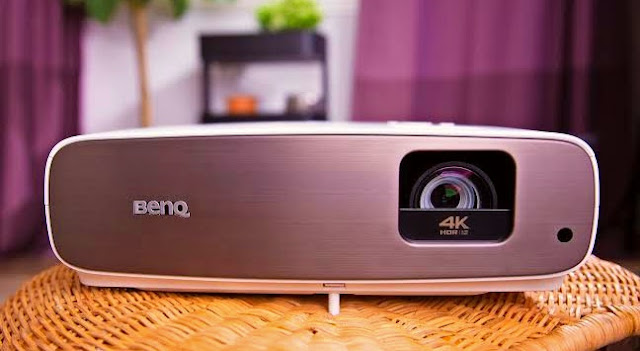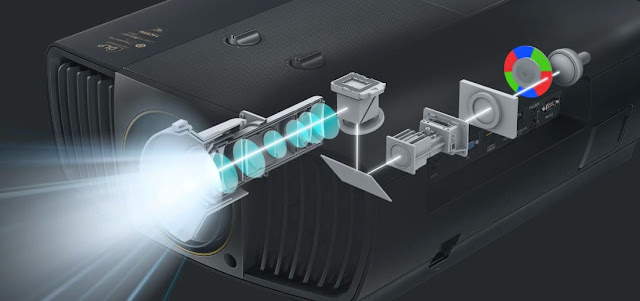Is CinematicColor the beginning of replacing monitors with projectors ?
Is CinematicColor the beginning of replacing monitors with projectors ?
 |
| projectors |
Projectors have become an essential part of many places and are difficult to do without in companies, schools and universities because of the ease of movement and large screen size appropriate for the growing numbers in those places.
But with the increased reliance on these devices, especially against monitors and TVs, it has remained a favorite of many when watching high-definition content or when playing video games.
It extends when people watch their favorite content, be it movies, TV shows or sports games, most prefer to rely on television screens in exchange for projectors ,
The main reason for this preference is the inability of projectors during the past years to keep pace with the quality of colors compared to what TVs offer. This is certainly something we all noticed when playing the same content on both devices .
• Are the projectors to the extent of competing TVs in terms of color?
Competition between projectors and TVs in terms of color quality has been lacking for years and years unless the developers are left with only one solution: to study the process of broadcasting in the projectors and restructuring using new technologies to reach the level provided by TVs.
One of BenQ's new technologies is CinematicColor, which has proven to keep pace with the color quality of monitors and TVs.
This development was noticed in our experience with the CinePrime W2700, which prompted us to use this device as an alternative to TVs, instead of using it only in meetings we used in games and high-quality movies enjoying the quality that we have never seen in a projector.
Because we do not like to use new technologies without knowing the secret behind them, we decided to research what this technology has to offer to share with you today during the following lines.
• Accuracy of colors
 |
This remarkable experience led us to look at what distinguishes this new device compared to other devices that we have used even those from BenQ that did not provide similar quality.
Our research journey brought us to CinematicColor technology and its ability to improve the final image quality ,
But because we are not content with the brilliant names of new technologies, we have decided to go deeper into understanding what this new technology has to offer and take you on a short trip to show you how it works and why it offers the best experience in projectors?
The first step taken by CinematicColor technology is to try to consistently deliver the highest color quality without being affected by any other factors. Reaching this goal is prevented by several obstacles, most notably the different reception of the eyes of the users of the colors from person to person depending on the device used in the display of the image.
To overcome that obstacle, the solution was to rely on three credits at the same time: Rec. 709, DCI-P3 and D65 accreditation, accredited by ITU or ITU to ensure that all devices displaying high-resolution content have the same color quality, refresh rate and video specifications.
• Pay attention to the color of the light source
To ensure that the three colors of the previous accreditation are achieved, particularly Rec. 709 It was necessary to pay attention to all the steps of the process of broadcasting the image starting from the light source. BenQ's R&D team studied the light emitted by the projectors to see the behavior of the color spectrum from the lens to the collision of the display.
This research has reached the company to use a new technology that determines the behavior of light emitted by the devices to maintain the color temperature and quality when they reach the display screen and not when they exit the lens to be the final colors meet the conditions for the adoption of Rec. 709 for colors.
• RGBRGB Color Wheel
After checking the quality of the light emitted by the light bulb, the next step is to hit the light with the color wheel. In CinematicColor-supporting devices, BenQ was interested in using nanometer-color wheels with more than 20 angles and coatings tested to ensure that the colors released eventually achieved Rec. 709 from all sides .
• Get rid of excess lighting
One of the problems faced by monitors in general is the increase in the amount of light emitted which may lead in some scenarios to change the color tone, especially in black color ,
This would make the previous steps useless, so it was necessary to develop a new system of lenses that manages the amount of light from the lenses of their new devices by making sure that the light passes on the DMD chip before going through the internal lenses coated with a heat-insulating coating.
• Preset calibration
In the end, to ensure the success of CinematicColor, BenQ offers its devices to users after pre-calibrating their devices before exiting their factories.
The calibration process for devices supporting CinematicColor technology includes calibration of D65 color temperature, gamma rays, black level, neutral white and gray level, RGBCMY color tracking, color tone, saturation, brightness and output from different interfaces according to Rec Rec. 709.
The impact of CinematicColor in the previous steps and attention to small details at every stage enabled BenQ to rely on its new technology to promote that its projectors offer an unparalleled experience.
Some may argue that this claim may be false and that new monitors are the same as those of other monitors, but our experience of BenQ CinePrime W2700 revealed to us the opposite, especially that the technology does not work alone, but amid a host of other features that make us replace a lot of screens with this device Without losing the full experience.
Is CinematicColor the beginning of replacing monitors with projectors ?
 Reviewed by olymbTricks
on
September 26, 2019
Rating:
Reviewed by olymbTricks
on
September 26, 2019
Rating:
 Reviewed by olymbTricks
on
September 26, 2019
Rating:
Reviewed by olymbTricks
on
September 26, 2019
Rating:
















LCD Projectors give more clear, more keen pictures than the greater part of their partners, they make pictures by sparkling light through three little LCD home theater projector screen
ReplyDeleteIt is perfect time to make some plans for the future and it is time to be happy. I’ve read this post and if I could I desire to suggest you few interesting things or tips. Perhaps you could write next articles referring to this article. I want to read more things about it! motorized projector screen
ReplyDeleteThe flat screen computer monitor or more commonly known LCD computer monitor is the main type of monitor produced today. It offers a sharper image than the CRT monitor, usually flat screen to save on space and is lighter in weight compared to the CRT model. monitor for coding
ReplyDelete